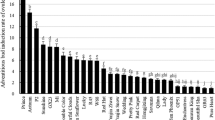Abstract
Hybrid varieties dominate the red beet market. The breeding process necessary to produce these cultivars is very difficult and time consuming. The application of in vitro gynogenesis can reduce the time needed to produce the corresponding homozygous pure lines to a few months. Our research team has developed a method to obtain red beet doubled haploid plants by gynogenesis. The best medium for gynogenesis induction is the B5 medium with the addition of 0.5 mg/L IAA, 0.2 mg/L BA, and 322 mg/L putrescine, whereas the best medium for shoot induction from embryos proved to be the MS medium supplemented with 0.1 mg/L NAA, 0.1 mg/L BA, and 0.5 mg/L putrescine. The shoots obtained were rooted on MS medium containing half the concentration of microelements and 3 mg/L NAA, 160 mg/L putrescine, and 20 g/L sucrose. Ploidy evaluation of gynogenetic plants was performed by flow cytometry and homozygosity or heterozygosity was determined by two isoenzymatic systems: PGI and AAT.
Access this chapter
Tax calculation will be finalised at checkout
Purchases are for personal use only
Similar content being viewed by others
References
Murovec J, Bohanec B (2012) Haploids and doubled haploids in plant breeding biochemistry, genetics and molecular biology. In: Ibrokhim Y (ed) Plant breeding, vol 5. IntechOpen, London, pp 1–21
Hosemans D, Bossoutrot D (1983) Induction of haploid plants from in vitro culture of unpollinated beet ovules (Beta vulgaris L.). Z Pflanzenzücht 91:74–77
Bossoutrot D, Hosemans D (1985) Gynogenesis in Beta vulgaris L: from in vitro culture to the production of doubled haploids plants in soil. Plant Cell Rep 4:300–303
Gürel S, Gürel E, Kaya Z (2000) Doubled haploid production from unpollinated ovules of sugar beet (Beta vulgaris L.). Plant Cell Reprod 19:151–159
Wremerth-Weich E, Levall M (2003) Doubled haploid production of sugar beet (Beta vulgaris L.). In: Maluszynski M, Kasha KJ, Forster BP, Szarejko I (eds) Doubled haploid production in crop plants – a manual. Kluwer, Dordrecht/Boston/London, pp 255–265
Gośka M, Krysińska T, Strycharczuk K (2004) The use of in vitro gynogenesis for obtaining sugar beet dihaploids. IHAR Bulle 234:27–14
Nagl N, Mezei S, Kovačev L, Vasić D, Čačić N (2004) Induction and micropropagation potential of sugar beet haploids. Genetik 36(3):187–194
Tomaszewska-Sowa M (2010) Cytometric analyses of sugar beet (Beta vulgaris l.) plants regenerated from unfertilized ovules cultured in vitro. EJPAU 13:4
Barański R (1996) In vitro gynogenesis efficiency in red beet (Beta vulgaris L) effect of ovule culture conditions. Acta Soc Bot Pol 65:57–60
Górecka K, Kowalska U, Kiszczak W, Burian M, Kapuścińska A, Fornal L (2014) Receiving red beet plants by gynogenesis and their evaluation. The 6th ISHS Balkan Symposium on Vegetables and Potatoes, (BSVP), Zagreb, September 29–2 October, 2014, p 90
Van Geyt J, Speckmann GJ Jr, D’Halluin K, Jacobs M (1987) In vitro induction of haploid plants from unpollinated ovules and ovaries of the sugarbeet (Beta vulgaris L). Theor Appl Genet 73:920–925
Klimek-Chodacka M, Baranski R (2013) Comparison of haploid and doubled haploid sugar beet clones in their ability to micropropagate and regenerate. Electron J Biotechnol 16(2):1–10
Pazuki A, Aflaki F, Gürel E, Ergül A (2017) Gynogenesis induction in sugar beet (Beta vulgaris) improved by 6-benzylaminopurine (BAP) and synergized with cold pretreatment. Sugar Tech 20:69–77
Chu CC, Wang CC, Sun CS, Hsu KC, Yin KC, Chu CY, Bi FY (1975) Establishment of an efficient medium for anther culture of rice through comparative experiments on the nitrogen sources. Sci Sinica 18:659–656
Gamborg OL, Miller RA, Ojima K (1968) Nutrient requirements of suspension culture of soybean root cells. Exp Cel Res 50:148–151
Murashige T, Skoog F (1962) A revised medium for rapid growth and bioassays with tobacco tissue cultures. Physiol Plant 15:473–497
Gośka M (1985) Sugar beet haploids obtained in the in vitro culture. Bull Pol Acad Sci Biol Sci 33:31–33
Hansen AL, Plever C, Pedersen HC, Keimer B, Andersen SB (1994) Efficient in vitro chromosome doubling during Beta vulgaris ovule culture. Plant Breed 112:89–95
Svirshchevskaya A, Dolezel J (2001) Karyological characterization of sugar beet gynogenetic lines cultured in vitro. J Appl Genet 42(1):21–32
Górecka K, Krzyżanowska D, Kiszczak W, Górecki R (2005) Embryo induction in anther culture of Daucus carota L. veg crops. Res Bull 63:25–32
Górecka K, Kiszczak W, Krzyżanowska D, Kowalska U, Kapuścińska A (2014) Effect of polyamines on in vitro anther cultures of carrot (Daucus carota L.). Turk J Biol 38:593–600
Westphal L, Wricke G (1989) Genetic analysis of DIA, GOT and PGI isozyme loci in Daucus carota L. ssp. sativas. Plant Breed 102:51–57
Galbraith DW (1984) Flow cytometric analysis of the cell cycle. Cell Cult Som Cell Genet Plants 1:765–777
Author information
Authors and Affiliations
Corresponding author
Editor information
Editors and Affiliations
Rights and permissions
Copyright information
© 2021 The Author(s), under exclusive license to Springer Science+Business Media, LLC, part of Springer Nature
About this protocol
Cite this protocol
Kiszczak, W., Burian, M., Kowalska, U., Górecka, K., Podwyszyńska, M. (2021). Production of Homozygous Red Beet (Beta vulgaris L. subsp. vulgaris) Plants by Ovule Culture. In: Segui-Simarro, J.M. (eds) Doubled Haploid Technology. Methods in Molecular Biology, vol 2289. Humana, New York, NY. https://doi.org/10.1007/978-1-0716-1331-3_20
Download citation
DOI: https://doi.org/10.1007/978-1-0716-1331-3_20
Published:
Publisher Name: Humana, New York, NY
Print ISBN: 978-1-0716-1330-6
Online ISBN: 978-1-0716-1331-3
eBook Packages: Springer Protocols




